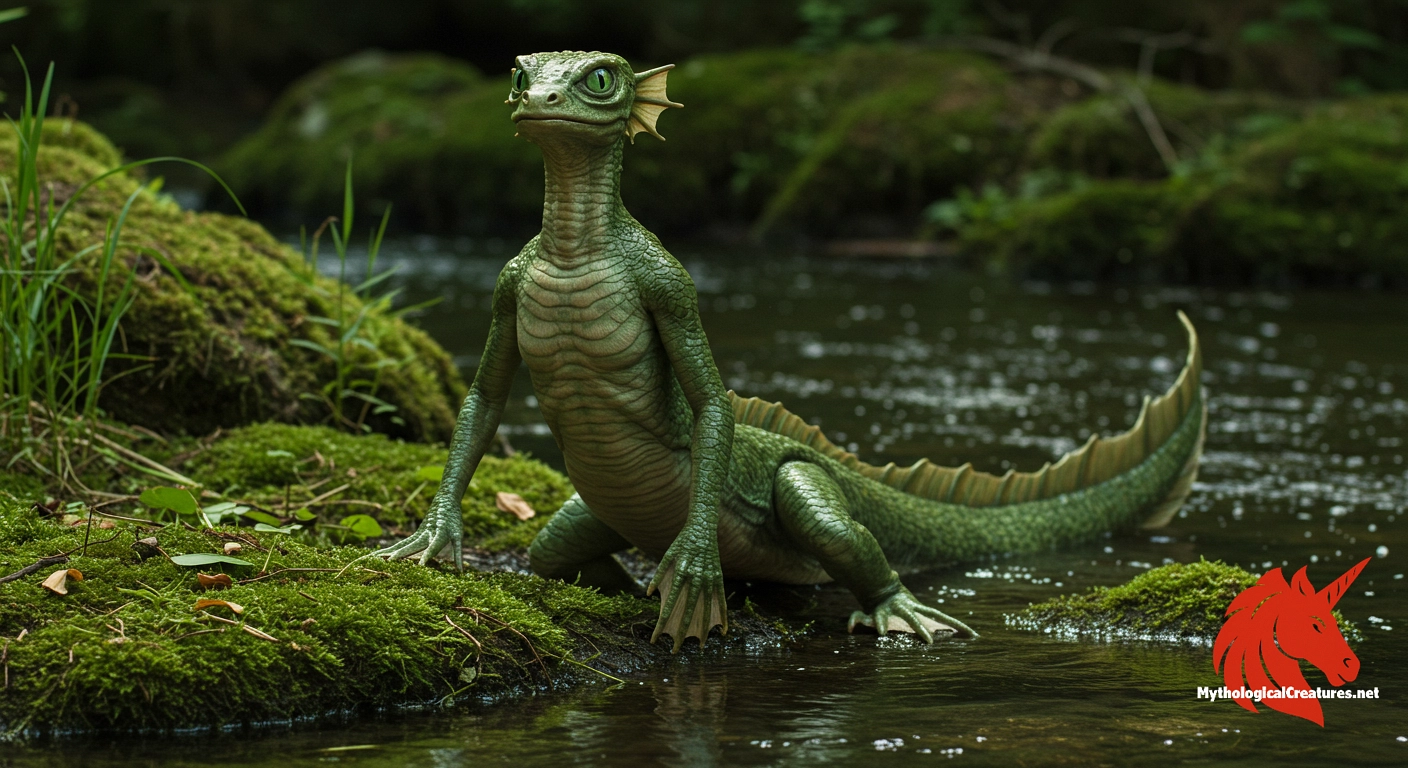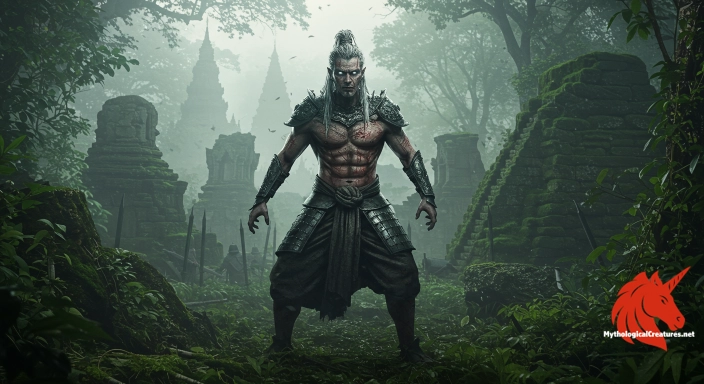Kuzenbo: Kuzenbo is the king of kappa in Japanese mythology, ruling over his kind in the waters of the Chikugo River.

Kuzenbo
Kuzenbo - Kuzenbo embodies the intricate folklore surrounding water spirits in Japan, representing both the benevolent and mischievous aspects of kappa.
Origins & First Encounters
Kuzenbo emerges as a majestic figure in Japanese mythology, recognised as the sovereign ruler of the kappa and the enigmatic forces of water. Born from the mists of ancient folklore, his origins are interwoven with the natural landscapes of Japan, where human interaction with water spirits was both revered and feared. His first clear attestation appears in regional narratives along the Chikugo River, a waterway emblematic of life and mystery in the local lore. He is occasionally referred to as Kusenbo or Kyusenbo, reflecting the evolution of oral traditions over centuries.
Residing along the banks of the Chikugo, his presence encapsulates a dual nature: one that offers protection to river communities and simultaneously warns of nature’s unpredictability. Kuzenbo is depicted as both a guardian and a trickster, whose actions underscore the delicate balance between human society and the untamed world. His myth is a tapestry of respect, fear, and a hint of playful mischief, marking him as a timeless symbol of aquatic power. Local customs and rituals have long celebrated his influence, with seasonal festivals and water rites honouring his legacy. His enduring role continues to shape cultural perspectives on the interplay between nature and civilisation.
Source Texts & Tale Variants
Ancient records of Kuzenbo can be found in various temple manuscripts and local narrative collections, although his presence is often alluded to under broader depictions of water deities. Oral histories passed down through generations in Chikugo’s rural communities richly detail his feats and divine interventions. Some variants of his myth recount dramatic encounters with local farmers during seasons of hardship, where his intervention was both awe-inspiring and cautionary. In other storylines, he is portrayed as a capricious spirit whose unexpected acts served as moral lessons for the unwary. Edo period texts, along with illustrated scrolls, provide vivid albeit fragmentary glimpses into his identity as a majestic kappa overlord. Regional folklore compilations present a series of narrative variants that blend historical observations with imaginative reinterpretations. The diverse accounts often vary in tone, with some emphasising his benevolence and others highlighting his retributive character. Contemporary retellings in literature and theatre further enrich his legend, merging historical sources with creative embellishments to create a multifaceted mythos.
Form & Powers
Kuzenbo is traditionally depicted with the defining attributes of kappa, yet his appearance is elevated by an unmistakable regal mien. He possesses an elongated humanoid shape that is both lithe and powerfully built, with a body covered in smooth, water-like scales. A distinctive feature is the shallow, dish-like depression on his head, which holds water and symbolises both vitality and vulnerability. His eyes are deep and reflective, capturing the mysterious essence of the river depths he calls home. Limbs equipped with webbed fingers and toes underscore his inherent connection to aquatic life, enabling him to navigate water with ease. He is sometimes shown wearing traditional adornments, where natural elements such as river reeds or carved stones serve as a crown. Some depictions include subtle draconic hints, such as flowing fins along his arms or a sinuous tail, which elevate his status among water spirits. The flexibility of his size—oscillating between towering majesty during regal displays and a more modest form in everyday appearances—further magnifies his mythic allure. His entire form is a harmonious blend of nature’s harsh beauty and mystical elegance, marking him as a singular icon among the kappa.
Regional Faces
Regional narratives reveal a fascinating spectrum of interpretations for Kuzenbo, tailored to local customs and the character of the surrounding environment. In the Kyushu area, where the Chikugo River meanders through lush landscapes, he retains a commanding presence as both a water deity and a protector against natural calamities. Local legends often describe him as adapting his physical guise to mirror the rugged terrains, sometimes taking on traits that verge on the beastly or even serpentine. In villages along the riverbanks, seasonal festivals vividly recount his miraculous interventions during times of environmental stress. Urban retellings, meanwhile, cast him in a subtler light, aligning his myth with contemporary concerns over water management and ecological balance. These adaptations show how community values and geographical specifics can mould the same myth into diverse forms. Despite differences in detail, all regional versions maintain the central motif of his dual nature—capable of both nurturing life and unleashing nature's might. The regional variations collectively enhance his legend, ensuring that his myth remains vibrant and relevant across Japan's varied cultural landscapes.
Cultural Parallels
Kuzenbo’s myth is enriched by intriguing parallels with other aquatic deities and folklore figures across cultures, showcasing a universal resonance with water symbolism. His dominion over the kappa can be compared to the river gods in Chinese tradition, who similarly embody both nurturing and formidable aspects of water. The dual character of protector and trickster is echoed in the legends of Celtic water sprites and European water demons, where nature’s benevolence is always tempered by latent danger. In many ways, his myth mirrors the broader archetype of the water spirit that functions both as a life-giver and a herald of nature's wrath. Visual motifs, such as the water-retaining feature on his head, create connections with symbols used in other cultures to indicate the ephemeral nature of water and life. His authoritative status among kappa is reminiscent of other mythic leaders who unify disparate elements of nature under a single, coherent spirit. Such cross-cultural comparisons highlight how various societies have sought to understand and personify the unpredictable power of water. Ultimately, Kuzenbo’s narrative stands as both a local legend and a universal allegory of nature’s capricious and all-encompassing force.
Legacy & Modern Evolution
Over time, Kuzenbo has evolved from an obscure water spirit into a complex symbol of environmental and cultural identity. In early folklore, his depiction was principally a cautionary tale interwoven with moral lessons about respecting nature. As centuries passed, his image gradually transformed, absorbing layers of social and ecological symbolism that mirror Japan’s intimate relationship with water. In modern cultural expressions, his story is often revisited in art, literature, and even digital media, where he symbolizes both heritage and ecological wisdom. Contemporary festivals along the Chikugo River continue to celebrate his myth, merging age-old rituals with modern environmental concerns. Artists and storytellers reimagine his form, often linking his regal yet mischievous character to broader narratives about sustainability and conservation. Academic discussions now analyse his myth as a reflection of shifting human attitudes towards nature, preserving the fascinating dualities of his persona. Today, Kuzenbo endures as a timeless emblem that bridges ancient tradition and modern cultural discourse, ensuring that his legend continues to inspire and provoke thought in an ever-changing world.
Interesting Fact
Legend has it that if a visitor manages to spill the water from a kappa's head dish, even Kuzenbo's powers can be severely weakened, highlighting the delicate balance of strength and vulnerability in these mythical beings.
Quick Creature Info
Features:
Associations:
Our Mythic Legendary Rating:

Also Sometimes Known As:
Habitat:
Supernatural Powers:
Physical Attributes:
Abilities:
Behavior:
Weaknesses:
Lore:
References
Discover Another Mythical Legend You May Not Have Heard Of?
Uncover the mysteries of ancient folklore and expand your knowledge of legendary beings from cultures around the world.
Dare to Meet the U Din Kyaw Khaung....
Mythical Disclaimer: The images and data on this site are derived from various historical and literary sources, but we have found that many myths often have multiple versions and interpretations across references, sometimes contradictory. As a result, these creature depictions are artistic interpretations—imaginative blends of folklore, legend, and a dash of AI guesswork. Because creature descriptions vary widely, our illustrations and accompanying information represent our best effort to honor mythology while bridging creative gaps. Enjoy these interpretations—just remember, we've done our best to respect the stories and validate available data, but in the realm of mythology, details often shift, imagination leads the way, and nothing is ever set in stone!
Curated by the Mythological Creatures Team (rev. May 2025)
